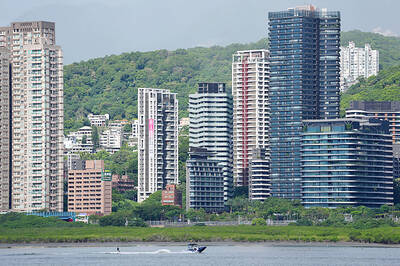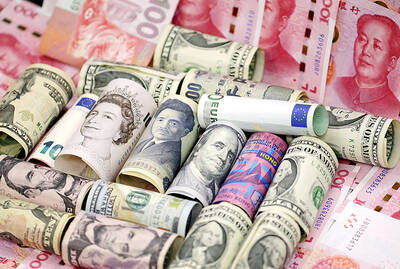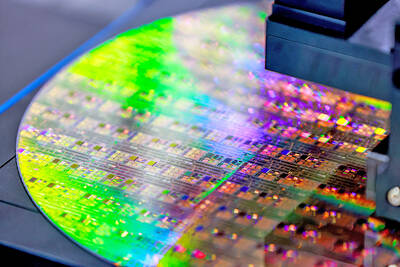Global liquid-crystal-display (LCD) panel makers could see their equipment utilization rate improve to nearly 80 percent in the current quarter and to more than 90 percent in the second half of the year, a market researcher said yesterday.
The rising utilization rate reflects a gradual recovery in end demand rather than a situation driven simply by inventory buildup, Austin, Texas-based DisplaySearch said at an annual flat-panel conference in Taipei.
CONFIDENCE
The researcher bases its confidence on faster-than-expected growth of LCD television sales in the first two months in North America, the world’s largest TV market.
Recovering demand may also drive up panel prices by around 9 percent quarter-on-quarter for TV panels and more than 10 percent for computer panels this quarter, following 3 percent quarterly hikes in the first quarter, DisplaySearch said.
NORTH AMERICA
David Hsieh (謝勤益), a vice president of DisplaySearch, said on the sidelines of the conference that LCD TV sales in North America grew more than 40 percent year-on-year in both January and February.
“We are optimistic about the LCD industry outlook,” Hsieh said. “In January and February, we already saw LCD TV demand pick up in China and North America. In April, demand in Europe should join the revival.”
“We are now almost certain that the recovery is underway and will be sustainable in the second half of this year,” Hsieh said, adding that demand may jump 30 percent quarter-on-quarter in the third and fourth quarters.
In light of recovering demand, DisplaySearch is considering raising its LCD TV panel shipment forecast to 140 million units this year, up 5.58 percent from its forecast of 132.6 million units globally, Hsieh said.
CHINA DEMAND
“We are seeing demand picking up, mostly from China, and the momentum may extend into the second half,” said Daniel Lee, a market director at the Taiwan branch of LG Display Co, the world’s No. 2 LCD panel supplier.
LG Display’s utilization rate improved to more than 90 percent in the first quarter from less than 70 percent in the fourth quarter, Lee said.

Taiwan’s rapidly aging population is fueling a sharp increase in homes occupied solely by elderly people, a trend that is reshaping the nation’s housing market and social fabric, real-estate brokers said yesterday. About 850,000 residences were occupied by elderly people in the first quarter, including 655,000 that housed only one resident, the Ministry of the Interior said. The figures have nearly doubled from a decade earlier, Great Home Realty Co (大家房屋) said, as people aged 65 and older now make up 20.8 percent of the population. “The so-called silver tsunami represents more than just a demographic shift — it could fundamentally redefine the

The US government on Wednesday sanctioned more than two dozen companies in China, Turkey and the United Arab Emirates, including offshoots of a US chip firm, accusing the businesses of providing illicit support to Iran’s military or proxies. The US Department of Commerce included two subsidiaries of US-based chip distributor Arrow Electronics Inc (艾睿電子) on its so-called entity list published on the federal register for facilitating purchases by Iran’s proxies of US tech. Arrow spokesman John Hourigan said that the subsidiaries have been operating in full compliance with US export control regulations and his company is discussing with the US Bureau of

Taiwan’s foreign exchange reserves hit a record high at the end of last month, surpassing the US$600 billion mark for the first time, the central bank said yesterday. Last month, the country’s foreign exchange reserves rose US$5.51 billion from a month earlier to reach US$602.94 billion due to an increase in returns from the central bank’s portfolio management, the movement of other foreign currencies in the portfolio against the US dollar and the bank’s efforts to smooth the volatility of the New Taiwan dollar. Department of Foreign Exchange Director-General Eugene Tsai (蔡炯民)said a rate cut cycle launched by the US Federal Reserve

Businesses across the global semiconductor supply chain are bracing themselves for disruptions from an escalating trade war, after China imposed curbs on rare earth mineral exports and the US responded with additional tariffs and restrictions on software sales to the Asian nation. China’s restrictions, the most targeted move yet to limit supplies of rare earth materials, represent the first major attempt by Beijing to exercise long-arm jurisdiction over foreign companies to target the semiconductor industry, threatening to stall the chips powering the artificial intelligence (AI) boom. They prompted US President Donald Trump on Friday to announce that he would impose an additional